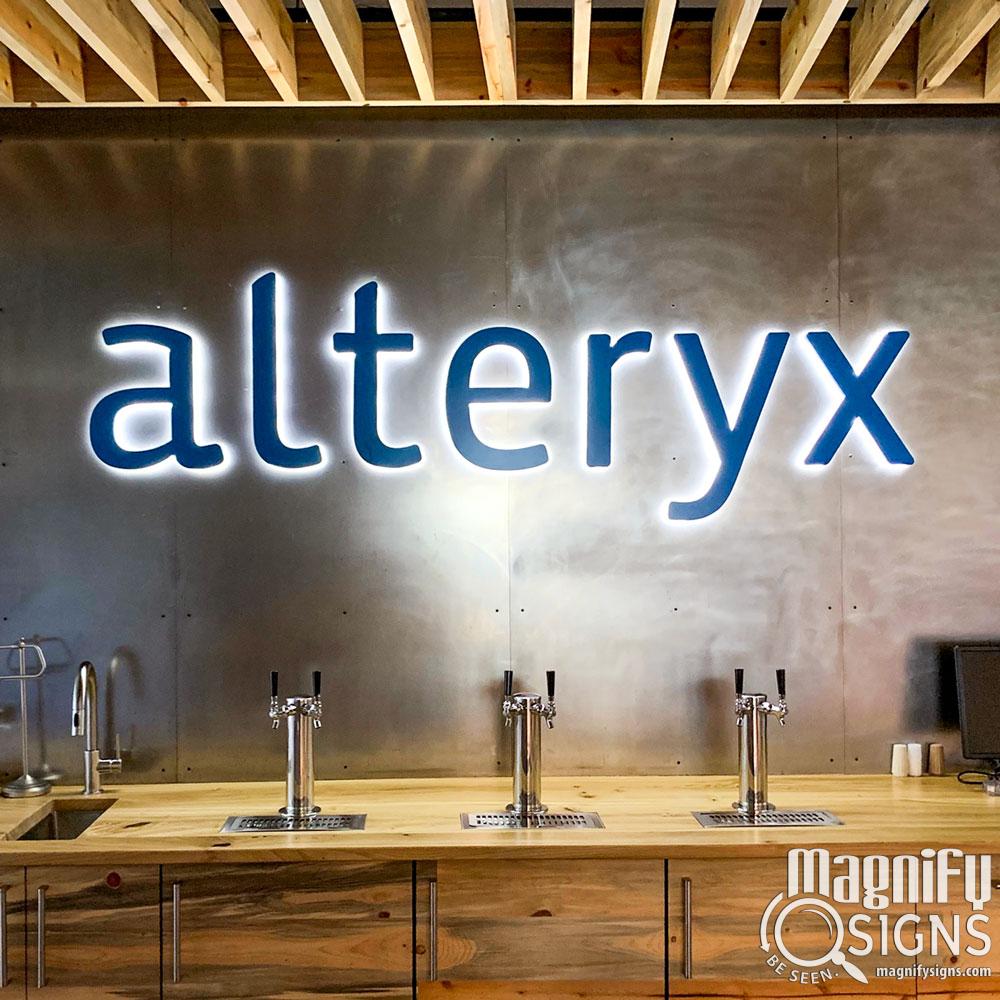Indoor signage can transform your office, business or store. Learn how to turn your office into a whole environment that tells your brand story. More importantly, let your store strategically convey an ambiance that makes your customers remember their shopping experience with you.
Why internal store signage is as important as external signage
Most store owners pay particular attention to their external signage, creating appealing storefronts to seduce customers into walking in. However, it is often the case that the interiors are not given the same care. Hand-written notes and poorly designed signs can destroy a store’s carefully crafted brand image.
Signage has several important functions to play in any store, from the boutique to the megastore. Here are some of the main ones.
Internal signs welcome potential customers
Many businesses have signage greeting the customer and setting the mood.
This can be signage at the wall behind a reception or service desk, on an easel, or on a banner at the entrance. Such signs start a dialogue between the office, business or store and the patron who walks in.
Directional signs guide customers around the premises
Directional signage is important, especially in large and multi-level stores, as it provides orientation to the customer.
From signs hanging above aisles to wall-mounted signs indicating the floor and department, directional and wayfinding signage helps customers find their way around without confusion.
Informational and advertising signage
Signage has to support your sales strategy and encourage purchases.
This can be achieved with temporary signage pointing to products and services that you want to promote, like special deals, new collections, unique offers, etc.
Required signage
In any business, there are signage requirements to be met, concerning safety and ADA (Americans with Disability Act) regulations.
Fire exits, maximum occupancy in elevators, stairways, etc. need to have signage that can be understood by people with disabilities.
Permanent rooms, whether used by customers or not, need signage which also needs to be tactile, according to ADA regulations. This includes restrooms, changing rooms, rooms for staff only, storage rooms, utility rooms, etc.
Any store will end up having several elements of internal signage. Often this is done incrementally, without a prior strategy or planning. This can end up in disparate, mismatched, or simply dull signage.
However, indoor signage can be functional without being boring. Environmental indoor store signage is one way to achieve this and to use indoor signage intentionally as part of your marketing strategy.
What is environmental indoor store design and signage?
 Environmental internal store design aims to create a physical space that people can connect to and that tells your brand’s story.
Environmental internal store design aims to create a physical space that people can connect to and that tells your brand’s story.
The aim is to shape a shopping experience that orients, informs, and delights employees, customers, and visitors alike. Signage has an important role to play in all of the above objectives.
Environmental signage includes wayfinding signage, retail signage, brand signage, etc. Increasingly, it also involves the use of digital technologies to present content and information in an interactive way.
A striking example of how indoor signage becomes part of the environmental design is the IKEA experience.
In IKEA stores, the floor works as a wayfinding system that takes the customers around the whole store (shortcuts are indicated more subtly). Display rooms with square feet information help the customer have a feel of what the products look like in a real environment.
Crucially, all products are tagged in the iconic IKEA fonts to provide full product information. All signage in the IKEA store conveys “Scandinavian design” and “practical but inexpensive,” seamlessly promoting their brand ideals.
Signage is not just complementary to the store idea, it almost seems like the whole store has been conceived around signage.
You don’t have to be a megastore like IKEA to apply environmental signage to your store, and of course, you don’t have to take your approach to such lengths. Just keep in mind that people walking into a store expect to find things easily. When they love the aesthetics and design they are more likely to actually shop and become repetitive customers. Combining function and aesthetics should be the goal of your signage.
How indoor store signage can help you with environmental design
If you are going for an environmental approach, your whole office, business or store can be the background for graphic design and signage. Think out of the little-sign-on-the-wall box and take advantage of all the possibilities that technology now offers to blend signage in your store design.
Here are some things to consider.
Convey and enhance your brand
Include your brand in your indoor office or store signage by taking into consideration the Pantone colors, fonts, and theme of your brand. These are not just for your exterior storefront. Use these elements or make sure that any other colors and fonts you select are complementary to your brand and logo.
You can also express your brand values and ideals by creating wall murals or wall banners to decorate bland walls while communicating a message to your customers.
 Welcome and greet your customers
Welcome and greet your customers
Use your entrance, lobby, reception desk, or service stations to develop signage that makes the customer feel welcome. Wall murals can enhance your ambiance and motivate customers to start a conversation with the staff.
Use your store’s architectural features
The architectural features of your business or store can make interesting supports for signage:
- Walls are an obvious support for signage. From wall-mounted signs to vinyl wall stickers with a theme relevant to your business, they are central to your signage.
- Pillars, round or square, can also be wrapped in printed vinyl. This can function as signage to indicate, for example, what department you are in, an upcoming event, a special sale, a new collection, and so on.
- The floor is a wide area that can be used for signing. You can use floor decals to provide direction or to display welcoming and inspirational messages to customers.
Call to action signage
Use signage to motivate or remind your customers to take action which is important for your strategy.
It can be permanent or temporary messages like “subscribe to our loyalty card,” “check out our new collection on the second floor,” “buy two for one,” “ask our staff,” or “recycle your printer cartridges here.”
Make your signage readable
When you create a whole graphic design environment that includes signage, it is easy to go too busy. Make sure that your message or signs stay distinctive and readable:
- Use large, bold fonts that are visible from a distance. Serif, lowercase fonts work better for distant signage.
- Fonts on a contrasting background are easier to read.
- Keep directional signs simple, clear, and direct.
Think community
In a small town or in a neighborhood where you know most of your customers by their name, it may be important for your business to nurture a spirit of community.
Decorate a space with a blackboard or bulletin board, where you can display local information, posters about local events, lost and found fliers, etc.
This way, printed material from other sources becomes part of your office or store environment in a controlled way.
Mix and match materials and supports
There are many different materials you can use to implement your interior signage, with different characteristics, durability, and cost. Each material is better suited for a different purpose. For example:
- Foam core is inexpensive and lightweight, with a matte, low glare finish. It is great for hanging aisle signage.
- Gatorboard is a rigid, resistant, and durable material that shows off vivid, high gloss colors. It is good for permanent wall-mounted signage.
- Ultra board is sturdy, durable, and scratch-resistant. This makes it a great material for high-use signage applications.
- Transparent acrylic can be used for standalone signs. It works well in open spaces and has a luxurious feel.
- Vinyl is printable and can be cut to any form or letters. It is easy to stick and detach. This makes it perfect for wall stickers, wall decals, or temporary signage.
- Static decals are ideal for temporary signage on glass and mirror surfaces.
Don’t hesitate to mix and match different materials and signage supports in your store, as long as you keep their purpose and aesthetics consistent.


